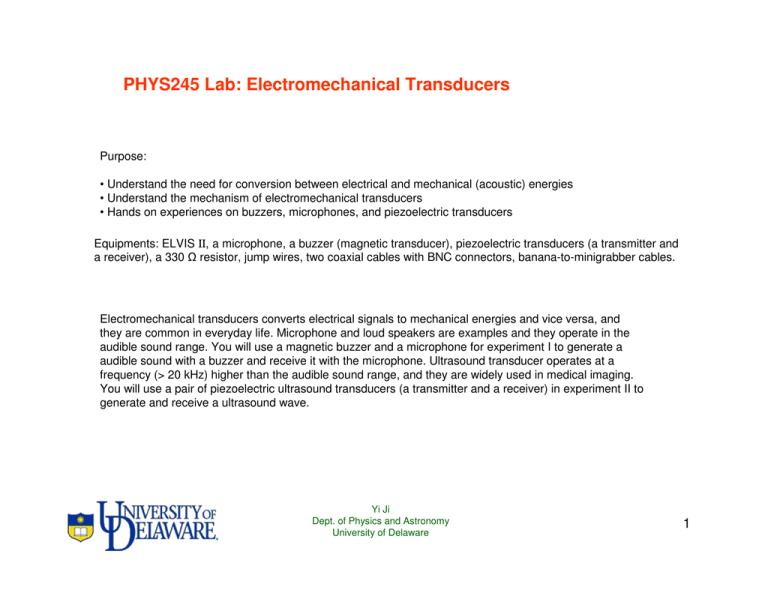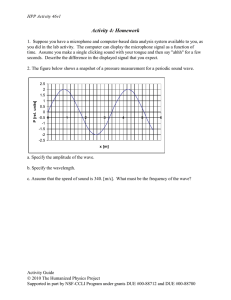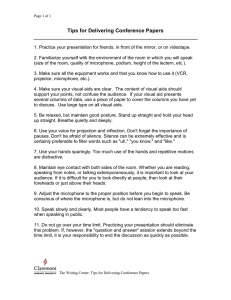Electromechanical Transducers - University of Delaware Dept. of
advertisement

PHYS245 Lab: Electromechanical Transducers Purpose: • Understand the need for conversion between electrical and mechanical (acoustic) energies • Understand the mechanism of electromechanical transducers • Hands on experiences on buzzers, microphones, and piezoelectric transducers Equipments: ELVIS ΙΙ, a microphone, a buzzer (magnetic transducer), piezoelectric transducers (a transmitter and a receiver), a 330 Ω resistor, jump wires, two coaxial cables with BNC connectors, banana-to-minigrabber cables. Electromechanical transducers converts electrical signals to mechanical energies and vice versa, and they are common in everyday life. Microphone and loud speakers are examples and they operate in the audible sound range. You will use a magnetic buzzer and a microphone for experiment I to generate a audible sound with a buzzer and receive it with the microphone. Ultrasound transducer operates at a frequency (> 20 kHz) higher than the audible sound range, and they are widely used in medical imaging. You will use a pair of piezoelectric ultrasound transducers (a transmitter and a receiver) in experiment II to generate and receive a ultrasound wave. Yi Ji Dept. of Physics and Astronomy University of Delaware 1 Pre-Lab exercises Practice the construction of circuits in the prototyping board picture on next page. • Inside a condenser microphone there is a capacitor with a fixed value of capacitance, true or false? • The current through a condenser microphone changes in response to a sound wave, true or false? • Both audible sound and ultrasound are propagating mechanical vibrations, but the frequencies are different, true or false? • A piezoelectric crystal vibrates when it receives a alternating electric voltage at proper frequency, true or false? • A piezoelectric crystal generates a alternating electric voltage, when a sound wave at proper frequency hit the crystal. Yi Ji Dept. of Physics and Astronomy University of Delaware 2 Yi Ji Dept. of Physics and Astronomy University of Delaware 3 Experiment Ι: Microphone and buzzer A microphone converts audio signals (acoustic waves) into electrical signals. The conversion into electrical signals allows for the recording, transmission, and amplification of audio signals. In this experiment, we use a condenser microphone (see figure below). There are two leads at the bottom of the microphone. They are connected to a parallel-plate capacitor inside the microphone. What is unique about this capacitor is that one of the two plates is a diaphragm, which is movable. When in operation, the two leads are connected to a 1.5 V d.c. voltage (battery or power supply). This voltage charge the capacitor. Upon receiving an acoustic wave, the diaphragm will vibrate in response, thereby changing the distance between the two plates rapidly. A oscillating distance implies a oscillating capacitance. Under the constant 1.5 V voltage, the charge on each plates should also oscillate in response. This gives rise a oscillating current through the two leads. The magnitude of the current as function of time mimics the magnitude of incoming acoustic wave as function of time. Thereby a mechanical vibration is converted into a electric signal. The microphone we use has a 2.2 kΩ resistance between the leads. So the capacitor is a “leaky” capacitor that allows for a small current flow. It operates at 1.5 V. Connect the circuit according to the diagram below. microphone A picture of a condenser microphone Scope Ch0 + 1.7 V from VPS R = 330 Ω Yi Ji Dept. of Physics and Astronomy University of Delaware 4 A 330 Ω resistor is put in series with the microphone. The voltage on the resistor is directed the Scope. As you have seen in one of the previously Labs, the voltage on the resistor is a representation of the current through the circuit. So the display on the Scope should tell us the charging current (of the capacitor inside the microphone) as function of time. The operating voltage can be obtained from the VPS (variable power supply). It is set to 1.7 V, considering the 330 Ω will take ~ 0.2 V, so that the microphone gets 1.5 V. Set up the Ch0 of the Scope with the following initial parameters: 50 mV/Div for Vertical scale and 50 ms/Div for timebase. Optional: The vertical position can be shifted toward the negative value so that the baseline of signal on the scope is near zero. Now clap your hands or snap your fingers above the microphone, and observe the pulses running across the Scope. These pulses represents the magnitude of the sound wave as function of time. You can change the Scope parameters a little and do the same exercises. For example, you can choose a smaller timebase (10 ms/Div or 5 ms/Div). This allows you to observe the electric analog of the sound wave more clearly. But you probably have to clap your hands more rapidly, because the scope is refreshing its display faster. Don’t try to speak into the microphone. The moisture from the mouth could deteriorate the prototyping board. Yi Ji Dept. of Physics and Astronomy University of Delaware 5 You can generate a sustaining acoustic wave using a buzzer, and then pick it up using the microphone. A buzzer transform a electric signal into a acoustic wave. This buzzer has a resonance frequency of 2.7 kHz. So the amplitude of the sound wave is the highest at this frequency. buzzer A sketch of the buzzer FGEN, 2.7 kHz Vpp = 2V Place the buzzer on the prototyping board, near the microphone. Direct a.c. signal from the FGEN to the buzzer, according to the diagram above. Don’t disconnect the microphone circuit. Activate the FGEN, and you will hear a loud sound from the buzzer. Now you can receive this sound wave using the microphone. Choose the Volts/Div and timebase on the Scope properly, so that you can see the electric signal which is an analogy of the sound wave generated by the buzzer. Measure the frequency of the electric signal. Compare it with the 2.7 kHz FGEN output that is driving the buzzer. Vary the frequency of the FGEN output, notice the pitch change and the intensity change of the buzzer sound. Observe the amplitude and frequency changes of the electric signal generated by the microphone. Yi Ji Dept. of Physics and Astronomy University of Delaware 6 Experiment ΙΙ: Piezoelectric transducers You will use a pair of piezoelectric transducers in the experiment: an ultrasound transmitter and an ultrasound receiver. The transmitter is essentially an ultrasound “buzzer” that turns electrical energy into ultrasound waves. The receiver is an ultrasound “microphone” that turns ultrasound wave into electrical signals. A picture of a piezoelectric transducer is shown on the left. Two jump wires are soldered to the electrical pins of the transducer to use on the prototyping board. The transmitter and the receiver look alike, but the transmitter has a larger diameter than the receiver. That is how you distinguish the two in this Lab. Piezoelectric materials are a type of the quartz crystals. When a electric voltage is applied to the crystal, its shape changes slightly. Conversely, when its shape changes, an electric voltage develops in the crystal. If a high frequency (e.g. 40 kHz) electric voltage is applied, the crystal vibrates at the same frequency and thus produces sound wave. This is how a piezoelectric transmitter works. When a ultrasound wave hit the crystal, the sound wave causes the crystal to vibrate and thus produces an a.c. electric voltage at the same frequency. This is how a piezoelectric receiver works. The medical ultrasonography is based on the same principle. A electric wave is feed to a transducer which generates the ultrasound wave. The sound wave transmits into the human body and is partially reflected by the tissues inside the body. The reflected wave is received by the transducer and converted into electric wave. By analyzing the intensity and the time elapse of the reflected wave, an image for the probed area inside the human body can be constructed. Yi Ji Dept. of Physics and Astronomy University of Delaware 7 Vpp = 10 V, f = 38 kHz transmitter receiver To Scope To FGEN Construct the circuit according to the diagram above. Place the transmitter near the receiver on the prototyping board. Send in a 10 V (peak-to-peak) 38 kHz a.c. signal to the transmitter. A ultrasound wave should be generated. Connect the receiver to the Scope, and display the a.c signal on the scope. This a.c signal is converted from the ultrasound wave that hit the crystal in the receiver. Use the right Volts/Div and timebase in the Scope to have a clear view of the signal. Now gently change the orientation of the transducers so that the top side (with a mesh) of the transducers are facing each other. The top side is the active region of the transducer, where the sound wave come out or is received. Be careful do not twist the wires too much. Now observe how the magnitude of the a.c. signal on the scope changes. Explain why. Let the top sides of the transducers facing up again. Hold a piece of paper (or a notepad) above the transducers. Observe how the magnitude of the signals on the Scope changes. Explain why. Measure the frequency of the a.c. signal in the Scope. Yi Ji Dept. of Physics and Astronomy University of Delaware 8



